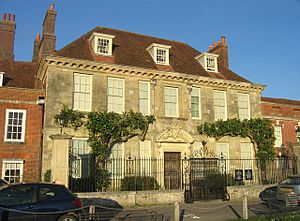Mompesson House facts for kids
Quick facts for kids Mompesson House |
|
|---|---|

South front
|
|
| Type | Mansion |
| Location | 53, The Close, Salisbury |
| OS grid reference | SU 14228 29731 |
| Area | Wiltshire |
| Built | 1701 |
| Architectural style(s) | Queen Anne |
| Owner | National Trust |
|
Listed Building – Grade I
|
|
| Official name: Mompesson House | |
| Designated | 28 February 1952 |
| Reference no. | 1355808 |
|
Listed Building – Grade I
|
|
| Official name: Screen wall, rails, piers, gates and overthrow in front of Mompesson House | |
| Designated | 12 October 1972 |
| Reference no. | 1253989 |
| Lua error in Module:Location_map at line 420: attempt to index field 'wikibase' (a nil value). | |
Mompesson House is a beautiful old house built in the 1700s. It's located in Salisbury, England, right near the famous Cathedral. This house is so special that it's protected as a Grade I listed building. Since 1975, the National Trust, a charity that looks after historic places, has owned and cared for it.
Contents
History of Mompesson House
The Mompesson family had lived in the area of Wiltshire for a long time. In 1635, Thomas Mompesson the elder moved to Salisbury. He leased some land and built a large house there.
Building the House
Later, Thomas's son, Sir Thomas Mompesson, decided to rebuild the property. He was a Member of Parliament for Salisbury several times. He started rebuilding in the late 1670s and also added a stable building next door. The land was bought at the end of the 1600s.
The house shows the classic Queen Anne style of that time. It also has influences from famous architect Christopher Wren. The house is built from a special type of stone called ashlar Chilmark stone. To the right of the main house, there's a brick building that used to be an old inn.
Completing the Design
Sir Thomas's son, Charles Mompesson, finished building the house in 1701. You can still see his initials and the date on the water pipes outside. These changes included a new stone front, making the house look much like it does today.
In 1703, Charles married Elizabeth Longueville. To celebrate, he added a special carving above the front door. It shows their family symbols joined together. After Charles passed away in 1714, Elizabeth's brother, Charles Longueville, moved in with her. In 1740, they added beautiful plasterwork, a grand staircase, and a new brick section.
Later Owners
After Charles Longueville's death, the house was passed down through his family. Later, three sisters from the Portman family lived there. The last sister, Henrietta, lived to be very old and passed away in 1846.
From 1846 to 1939, the Townsend family lived in Mompesson House. A very interesting artist named Miss Barbara Townsend lived there for all of her 96 years! She is even mentioned in a book called Four Victorian Ladies of Wiltshire. From 1942 to 1946, the Bishop of Salisbury, Neville Lovett, lived in the house.
National Trust Ownership
In 1952, an architect named Denis Martineau bought the house. He did a lot of repairs and renovations. He even opened the house to visitors a couple of afternoons each week. When he passed away in 1975, he left Mompesson House to the National Trust. This was part of the agreement when he bought it.
The beautiful iron gates, railings, and lamps at the front of the house are also very old and important. They are listed separately as Grade I, just like the house itself.
Collections Inside Mompesson House
Mompesson House has amazing plasterwork and carvings from the Georgian period. The National Trust has carefully restored them, removing many layers of old paint.
When the National Trust took over the house, it was empty. Denis Martineau had left his furniture to his family. So, the Trust has decorated the rooms with furniture and items from the 1700s to match the house's style.
Special Displays
The dining room is a great example of the Georgian style. It also displays the Turnbull collection of English drinking glasses from the 1700s. These were given to the Trust in 1970.
The house also has the Bessemer-Wright collection of ceramics. This includes beautiful porcelain figures from famous factories like Derby and Bow. You can also see Sèvres plates and Wedgewood urns.


